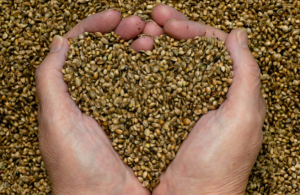Getting Real About The F-35, in Vermont?! (HUFF PO)
October 8, 2014Why Privacy Matters, by Glenn Greenwald (TED)
October 12, 2014Hemp Bound: Getting Beyond Marijuana’s Stoner Stigma in Vermont, by Michael Comitini (BOOK REVIEW)
21st century U.S. society is becoming more and more open to the recreational drug marijuana. In the past two years, two states have legalized the drug (Colorado and Washington). Many observers note that marijuana use – and the growth of this psychoactive drug – may soon be legalized throughout the United States, and most likely all of North America, adding a new and lucrative industry throughout the land. Many Vermonters remain supportive of this possibility, and our once and future Vermont republic is sometimes stereotyped as a haven for stoners.
Although national media stories often consider the psychoactive drug part of the industry to be the only way to make money, Hemp Bound: Dispatches from the Front Lines of the Next Agriculture Revolution, written by Doug Fines, illustrates in simple and visual terms that there is a much larger picture to be painted when looking at North American hemp growth. The plants that are considered psychoactive and the plants explored in Fines’ book are actually different plants – known as “cousins.” Fines’ account introduces the reader to multiple ways that hemp has been used historically in our society, and can again be harvested as we enter the 21st century.
A bit of background. Doug Fines is a journalist, author and goat herder residing in New Mexico. He is known for writing environmental journalistic material and has been publishing books since 2004. As Fines says in his book, it is time for us to see beyond marijuana’s smoky stigma to the endless opportunities afforded by hemp. One harvest can be used for food, industrial parts, and energy, according to Fines. There are few states that have legalized and have begun growing hemp for these types of crops, including right here in our own Vermont. Although the federal government hasn’t legalize hemp, there are groups in Vermont such as Vote Hemp, based in Brattleboro, who trying to help the cause nationwide.
From the book’s beginning, Fines shares eye-opening facts about hemp – It doesn’t take long for Fines to let us know that Thomas Jefferson wrote the Declaration of Independence draft on hemp paper, and Betsy Ross stitched the U.S.’s first flag from the cannabis plant. Fines also highlights contemporary uses of the plant. An Australian man named Adrian Francis K. Clark invented a machine called a decorticator which will allow farmers to not only harvest the plant for its seeds but also its extremely strong industrial fiber. Fines visits the Composites Innovation Centre in Winnipeg, where they are making such things as tractor hoods out of this incredible plant. Possibly the most exciting resource that can be pulled from the cannabis plant is related to energy. Fines interviews entrepreneurs such as Roger Ford, CEO of Patriot Bioenergy, who is promoting cannabis as the next, better biodiesel type fuel. Fines also took a trip in a cannabis-powered vehicle which demonstrated that this form of energy is far better for the environment than petroleum – Fines concludes that the cannabis-powers car wasn’t as noisy as many oil-powered cars being sold today, and ran more efficiently.
One of the most common uses of cannabis that isn’t as known in North America is the cannabis seed. Many cultures have been eating hemp seed for thousands of years. I myself have tried hemp seed – it is tasty on its own as well as in foods such as salads. The seed is filled with plenty of nutrients, as Fines emphasizes. In conclusion, Hemp Bound is an important book chronicling what maybe become the next big agricultural industry in North America.
For more revolutionary writing, visit Chelsea Green Publishing.
Share this:
- Click to print (Opens in new window)
- Click to email a link to a friend (Opens in new window)
- Click to share on Twitter (Opens in new window)
- Click to share on Facebook (Opens in new window)
- Click to share on Reddit (Opens in new window)
- Click to share on LinkedIn (Opens in new window)
- Click to share on Tumblr (Opens in new window)

